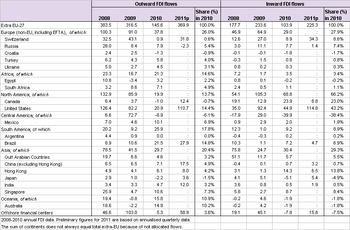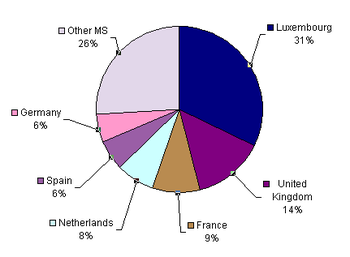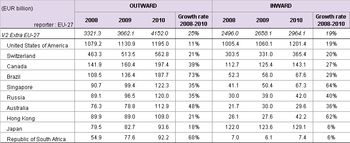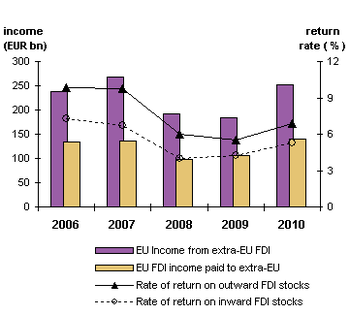Archive:Foreign direct investment statistics
- Data from June 2012, most recent data: Further Eurostat information, Main tables and Database.
EU Foreign Direct Investment (FDI) has started to recover after the recent global economic and financial turmoil. In 2011, EU outward flows increased for the first time after three consecutive years of decline, up 154 % compared with 2010. At the same time, EU inward flows doubled from the previous year — up 117 %. While making good some of the ground lost over the last three years, EU FDI flows still remained well below the record peaks of 2007 in both inward and outward investment relations with the rest of the world.
This article gives an overview of EU FDI statistics for year-end stocks, annual flows and income. The analysis mainly covers 2008 to 2010, but provisional data on flows for 2011 are included, based on annualised quarterly figures.
Main statistical findings

Source: Eurostat (bop_fdi_pos_r2)
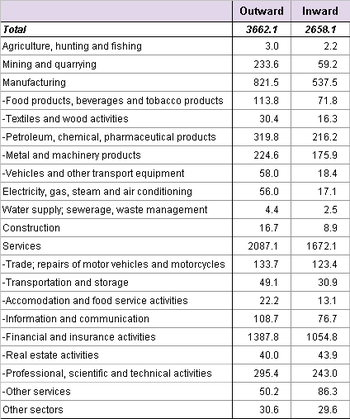
Source: Eurostat (bop_fdi_pos_r2)
Foreign direct investment returns to growth
In 2009, total FDI outflows dropped by 17 %, mainly due to a two-fold decrease in 'other capital'. In 2010, they declined by a further 54 %, explained by a sharp drop in equity capital invested outside the EU.
Following the slight recovery in 2009, EU inward flows declined sharply in 2010 by 56 %, mirroring outflows. Equity and other capital both contributed to the negative change, while reinvested earnings retained their positive trend from 2008.
The income return from both EU outward and inward investment in 2010 was up from the previous year, but remained below the record levels of 2007.
In 2011, EU investment vis-à-vis the rest of the world increased, partially confirming the signs of global economic recovery after the crisis. As in earlier years, FDI flows channelled through Special Purpose Entities (SPE)[1] played a very significant role in the results for 2011.
FDI flows see recovery after 2008-2010 downturn
In 2008-2010 EU FDI flows were largely affected by the global economic and financial crisis. In 2010, both outward and inward flows halved compared with the previous year's levels. As in 2009, the decline in EU investment abroad was mainly due to the sharp drop in transactions with the EU's main partners — the United States (down 75 % to EUR 20.9 billion) and Switzerland (down to only EUR 0.9 billion). In 2010, Offshore Financial Centres (OFC) fell sharply to only EUR 5.3 billion, accounting for EU disinvestment in Central America, where some of the OFC are located.
The same three partners were strongly implicated in the drop in EU incoming investments in 2010. US and Swiss flows into the EU declined by 51 % and 67 % respectively, while the OFC recorded disinvestments of EUR 7.8 billion. SPEs played an important role in all these developments.
On the other hand, some less traditional partners have become more attractive for EU investment. In Brazil, for instance, flows tripled from 2008 to 2011. In 2010, Brazil was even the main destination for EU outflows, ahead of the United States.
Provisional figures for 2011 show signs of a recovery in EU outflows for all main partners. The exception is Russia, where the EU-27 recorded disinvestment of EUR 2.3 billion. The EU FDI with the United States, Switzerland and the OFC grew substantially, to account for 54 % of EU total outflows to and 73 % of inflows from the rest of the world in 2011.
Outward FDI into Canada dropped into disinvestment in 2010, but recovered in 2011 to investment of EUR 12.4 billion. In 2010, Canada was the second largest investor into the EU with EUR 23.9 billion, but this figure was down to EUR 6.8 billion in 2011.
EU investment flows with economies in South-East Asia have been less affected by the crisis. There were indications of a recovery in 2010, except for Japan, where the EU recorded disinvestment in both directions. The preliminary results for 2011 show further improvement, China (EUR 17.5 billion) and India (EUR 12.0 billion) being the main destinations, and Hong Kong (EUR 6.5 billion) and Japan (EUR 5.4 billion) the main source of EU FDI.
In 2010, Australia attracted 10 % (EUR 14.9 billion) of EU total investment abroad but withdrew EUR 1.9 billion from the EU, reversing the previous year's bilateral FDI relations.
EU’s main sources of outgoing FDI
FDI flows can vary considerably from one year to another, influenced mainly by large mergers and acquisitions. Luxembourg has a large share (31 %) of EU FDI outward flows because Special Purpose Entities (SPEs)1 handle about 85 % of Luxembourg’s total direct investment. SPEs also play an important role in other EU Member States, especially the Netherlands and Hungary, but the data given here for these two countries exclude SPEs.
Luxembourg's outgoing FDI halved in 2010 compared with 2009, though Luxembourg remained the leading EU investor in non-EU countries. Bermuda, the United States and Switzerland were the three top destinations for FDI from Luxembourg, showing the importance of the financial sector for the country.
The United Kingdom recorded a sharp drop in its investment in non-EU countries. In 2010, there was even disinvestment in its traditional partners like the United States and Canada, though investment increased in South-East Asia, Australia and Brazil.
FDI stocks with moderate growth in 2010
EU outward and inward stocks (or positions) grew steadily in 2010: outward stocks by 13 % and inward stocks by 12 %, compared with 10 % and 6 % respectively in 2009.
North America continues to hold the biggest share of non-EU countries’ stocks
At the end of 2010, North America had the biggest share (34 %) of non-EU stocks. The United States accounted for some 28 % (EUR 1195.0 billion) of total EU outward stocks, but the rate of growth (5.7 %) was down over previous years. The main holders of EU FDI stocks in the US were the United Kingdom (18 %), France (14 %) and Germany (14 %).
Switzerland was the second most important destination for EU FDI positions in 2010, accounting for 14 % of total stocks, the main activity sector being financial intermediation. Canada was the third main destination, with a 4.8 % share.
EU stocks in Brazil grew by 73 % in 2008-2010, confirming the growing interest of EU investors in this region.
In Asia, the main holders of EU stocks were Singapore, Hong Kong and Japan, together accounting for half of the EU positions in Asia in 2010. China has been growing steadily over recent years to reach EUR 75.1 billion in 2010, followed by Korea, India and Indonesia.
In Africa, the main destinations for EU stocks were South Africa (EUR 92.2 billion), Nigeria (EUR 34.5 billion) and Egypt (EUR 24.4 billion). EU positions in South Africa grew by 19 % in 2010, and the country remained among the EU’s top ten FDI partners.
The United States by far the major FDI stock holder in the EU
At the end of 2010, the United States accounted for 41 % (EUR 1201.4 billion) of total EU inward stocks from the rest of the world. The US thus consolidated its position as the major stocks holder in the EU, having invested, as of end 2009, mostly in the financial services sector, followed by manufacturing, one third of the latter being in metal and machinery production.
Similar to outward positions, Switzerland was the second biggest stock holder in the EU, with EUR 365.4 billion — 10 % more than in 2009.
Other countries with significant shares in EU inward positions were Canada, Japan, Brazil, Singapore, Hong Kong and Russia. Canada and Japan held 14 % and 4 % more FDI stocks respectively in 2010 compared with the previous year. In 2010, the highest annual growth among these partners was achieved by Hong Kong (51 %), followed by Singapore (34 %) and Brazil (21 %).
Continued dominance of Services
The activity-sector structure of EU-27 FDI stocks remained more or less unchanged in 2009. The EU had a positive FDI balance vis-à-vis the rest of the world in all major sectors.
Services made by far the largest contribution to both outward (57 %) and inward (63 %) stocks, and the respective shares in 2009 were slightly greater than in 2008. Almost two thirds of services stocks were held in financial and insurance activities, which themselves grew substantially from 2008. Almost all services sub-sectors contributed to the positive development, except for Trade (including repairs of motor vehicles) and Information and communication, where EU stocks decreased in both directions.
EU-27 stocks in manufacturing declined in 2009 both outward (-4 %) and inward (-5 %), reducing the importance of these activities to around 20 % of total stocks.
Construction shrank by almost a quarter to record the largest annual drop among the major sectors in 2009.
EU net income recovers in 2010
Following a two-year decline, the EU’s net FDI income resurfaced after the global financial crisis. The recovery in 2010 brought rates of return[2] up to 6.9 % for outward and 5.2 % for inward stocks.
The EU’s investment income grew by 36 %, almost fully cancelling out the drop in the previous two years. The income paid to non-EU countries increased to EUR 139.5 billion, exceeding the record level of 2007. The resulting net income from the rest of the world amounted to EUR 111.6 billion — 43 % more than in 2009. The EU’s FDI income balance in 2010 was 0.91 % of EU GDP, compared with 0.61 % in 2009.
Data sources and availability
Foreign Direct Investment statistics in the EU are collected in accordance with Regulation (EC) No 184/2005 of the European Parliament and of the Council Regulation 0184/2005 on Community statistics concerning balance of payments, international trade in services and foreign direct investment.
The methodological framework used is that of the OECD’s benchmark definition of foreign direct investment (third edition), which provides a detailed operational definition that is fully consistent with the IMF’s balance of payments manual (fifth edition).
This article is based on FDI data that were published in Eurostat’s database as at the beginning of June 2012. The series cover 1992-2010, broken down by partner, activity and type of investment (equity capital, loans and reinvested earnings). The less detailed FDI figures for 2011 are provisional results based on annualised quarterly Balance of Payments data.
EU aggregates include Special Purpose Entities (SPEs), which are a particular class of enterprises (often empty shells or holding companies) not included in all countries’ national statistics. Consequently, the EU aggregates are not simply the sum of national figures.
Context
In a world of increasing globalisation, where political, economic and technological barriers are rapidly disappearing, the ability of a country to participate in global activity is an important indicator of its performance and competitiveness. In order to remain competitive, modern-day business relationships extend well beyond the traditional foreign exchange of goods and services, as witnessed by the increasing reliance of enterprises on mergers, partnerships, joint ventures, licensing agreements, and other forms of business co-operation.
FDI may be seen as an alternative economic strategy, adopted by those enterprises that invest to establish a new plant/office, or alternatively, purchase existing assets of a foreign enterprise. These enterprises seek to complement or substitute external trade, by producing (and often selling) goods and services in countries other than where the enterprise was first established.
There are two kinds of FDI: namely, the creation of productive assets by foreigners or the purchase of existing assets by foreigners (acquisitions, mergers, takeovers, etc.). FDI differs from portfolio investments because it is made with the purpose of having control or an effective voice in management and a lasting interest in the enterprise. Direct investment not only includes the initial acquisition of equity capital, but also subsequent capital transactions between the foreign investor and domestic and affiliated enterprises.
Conventional trade is less important for services than for goods. While trade in services has been growing, the share of services in total intra-EU trade has changed little during the last decade. However, FDI is expanding more rapidly for services than for goods, increasing at a more rapid pace than conventional trade in services. As a result, the share of services in total FDI flows and positions has increased substantially, as the service sector within the EU-27 has become increasingly international.
Further Eurostat information
Publications
Main tables
- European Union direct investments (t_bop_fdi)
Database
- European Union direct investments (bop_fdi)
Methodology / Metadata
- European Union direct investments (ESMS metadata file - bop_fdi_esms)
Other information
External links
- OECD Benchmark Definition of Foreign Direct Investment
- United Nations Conference on Trade and Development (UNCTAD) - FDI Statistics
See also
- Africa-EU - economic indicators, trade and investment
- Balance of payment statistics
- Foreign affiliates statistics - FATS
- Global value chains - international sourcing to China and India
- Latin America-EU - economic indicators, trade and investment
Notes
- ↑ Special Purpose Entities are mainly financial holding companies, foreign-owned, and principally engaged in cross-border financial transactions, with little or no activity in the Member State of residence.
- ↑ The FDI rate of return is measured here as (FDI income of year t) / (stock of FDI at the end of year t-1).

